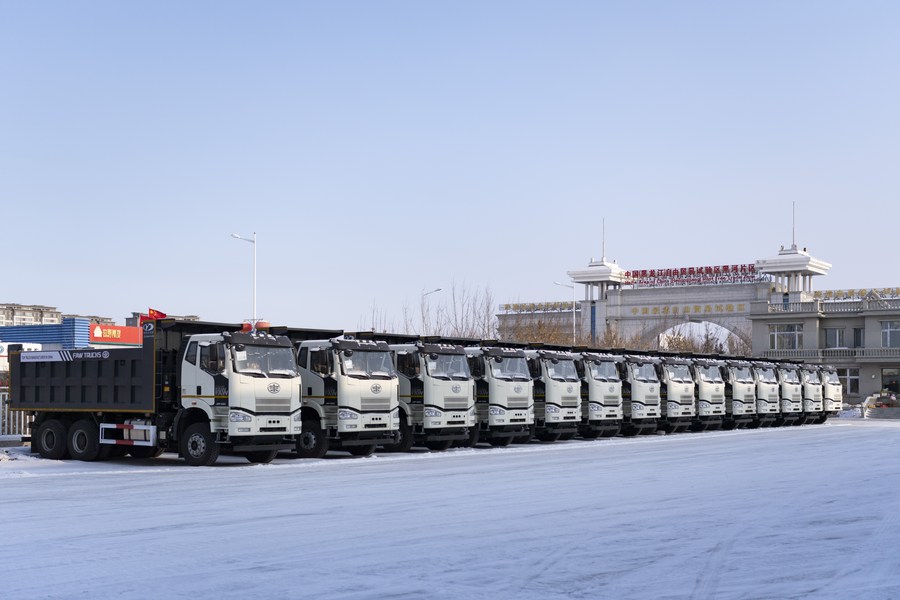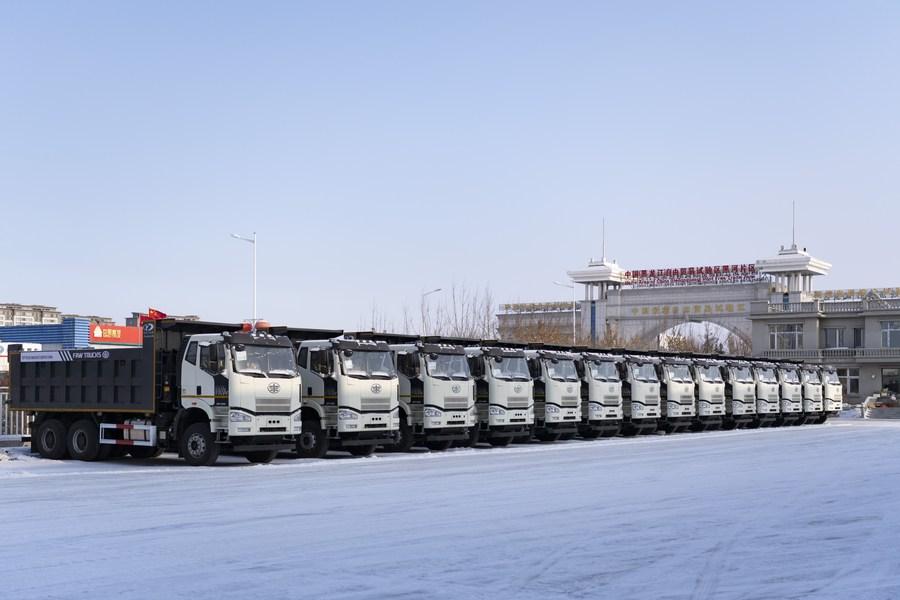
Vehicles to be exported are seen in the Heihe Area of China (Heilongjiang) Pilot Free Trade Zone in northeast China's Heilongjiang Province, Feb. 11, 2023. (Xinhua/Xie Jianfei)
BEIJING, March 16 (Xinhua) -- China's foreign trade remained generally stable in the first two months, with exports hitting a new high.
The country's imports and exports are expected to grow this year and continue supporting national economic growth.
In 2023, China will step up efforts to expand foreign trade markets and channels and foster new growth engines to stabilize its international trade.
-- Foreign trade still important pillar to stablize economy
Despite weakening economic and trade growth globally, China's foreign trade has remained generally stable with exports hitting a new high, serving as one of the mainstays to stabilize the macro economy.
Data released by the General Administration of Customs (GAC) showed that the country's foreign trade of goods edged down 0.8 percent year on year to 6.18 trillion yuan in the first the two months.
During the period, its goods exports rose 0.9 percent year on year to 3.5 trillion yuan.
Speaking of the growth, Lyu Daliang, director of GAC's statistics and analysis department, said that China's foreign trade has braved the challenges of multiple factors and continued to support the country's economic growth.
Since the beginning of February, China's foreign trade has seen overall improvements, said Lyu, stressing the significant growth in late February. He added the positive momentum is expected to continue according to relative indicators.
Lyu's prediction was echoed by Wei Jianguo, former vice minister of commerce, who expected the country's foreign trade to rebound rapidly in the second quarter.
The imports and exports in the whole year is expected to hit about 46 trillion yuan. In breakdown, exports are likely to reach around 26 trillion yuan and imports may stand at 20 trillion yuan, said Wei.
China's foreign trade is resilient with improving industrial chain, supply chain and logistics, Wei explained factors contributing to his projection.
He added that a larger circle of friends of China's foreign trade resulted from the implementation of the Regional Comprehensive Economic Partnership (RCEP) agreement and promotion of the Belt and Road Initiative (BRI) will also further unleash the potential for growth.
-- Cushioning fluctuation to achieve overall balance in foreign trade scale
In 2023, China will stabilize trade with traditional partners such as the United States, Europe, Japan and the Republic of Korea, and expand trade with emerging markets such as Latin America and Belt and Road (B&R) countries to keep its foreign trade stable, Wang Wentao, minister of the Ministry of Commerce (MOC) said in an interview earlier this month to China Securities Journal.
China's major trading partners remained unchanged, said Wei Jianguo, adding that the country's economy and other important economies are highly complementary.
In the first two months, the Association of Southeast Asian Nations (ASEAN) remained China's largest trading partner. China's trade with ASEAN countries rose 9.6 percent year on year to 951.93 billion yuan, accounting for 15.4 percent of the country's total, according to the GAC.
China's trade with B&R countries climbed 10.1 percent year on year to 2.12 trillion yuan, driving the overall growth of its imports and exports by 3.1 percentage points in the first two months.
The country's trade with other RCEP members rose 3.1 percent during the same period.
China will also stabilize foreign trade channels. Efforts will be made to use conventional channels such as the Canton Fair to boost trade, encourage enterprises to participate in overseas exhibitions, and galvanize localities, trade promotion agencies and business associations to carry out various forms of trade promotion activities, according to the MOC.
In recent months, many foreign trade enterprises in provinces including Zhejiang, Jiangsu, Sichuan, and Guangdong have endeavored to expand markets in the Europe, Japan, Indonesia, the United Arab Emirates, etc. by participating in local exhibitions, visiting clients and engaging in cooperation negotiations.
During the Spring Festival holiday, foreign trade enterprises in east China's Jiangsu Province went overseas and signed orders worth about 20 billion yuan.
From December 2022 to February 6 this year, 1,657 foreign trade enterprises in east China's Zhejiang Province have won more than 40 billion yuan of overseas orders of intent.
-- Better developing e-commerce, other forms into new engines of foreign trade growth
China will continue cultivating new engines driving trade growth during the process of industrial upgrading, Wang Wentao told China Securities Journal, a Xinhua-run daily newspaper.
Fast growing cross-border e-commerce has become a new driving force for China's foreign trade development.
Since the unfolding of 2023, Chinese central and local governments have unveiled a string of measures to speed up growth of cross-border e-commerce, including reducing tariffs levied on returned goods that have been exported via cross-border e-commerce channels, improving logistics infrastructure, and granting capital support for enterprises to build independent online transaction platforms.
Data from the GAC showed the value of China's cross-border e-commerce reached 2.11 trillion yuan in 2022, up 9.8 percent year on year.
So far, China has launched 165 comprehensive pilot zones for cross-border e-commerce in 31 provincial-level regions.
The pilot zones have effectively helped maintain the scale and structure of foreign trade, and promoted innovation and development of business models, Shu Jueting, spokesperson of the MOC told a press conference last month.
Meanwhile, with digital economy booming globally and bringing new opportunities to the development of international trade, China will move faster to boost digital trade, Wang was quoted as saying.
The country will support local governments in hosting trade digitalization exhibitions, and accelerate construction of global trade digitalization pilot zones in the Guangdong-Hong Kong-Macao Greater Bay Area.
In product end, electric vehicles, photovoltaic products and lithium batteries have become new growth engines for exports. MOC's data showed that China's exports of electric vehicles, photovoltaic products and lithium batteries in 2022 registered a year-on-year increase of 131.8 percent, 67.8 percent and 86.7 percent, respectively.
For example, about 170,000 new energy vehicles were exported from January to February, up 62.8 percent year on year, according to data released on March 10 by China Association of Automobile Manufacturers.
Exports of these products are expected to continue growing in 2023, Wang added.
(Edited by Su Dan with Xinhua Silk Road, sudan@xinhua.org)




 A single purchase
A single purchase









